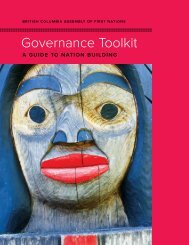program
program
program
You also want an ePaper? Increase the reach of your titles
YUMPU automatically turns print PDFs into web optimized ePapers that Google loves.
2C<br />
Drinking Water Safety Plans<br />
Graham Gagnon, Director, Centre for Water Resources<br />
Studies<br />
The state of drinking water and wastewater in First Nation<br />
communities is a recognized challenge across Canada. In June 2013,<br />
the Government of Canada passed Bill S-8: The Safe Drinking Water<br />
for First Nations Act. This will enable new regulatory paradigm for<br />
water regulation on First Nation lands. One such innovative regulatory<br />
approach are Drinking Water Safety Plans (DWSPs). DWSPs are a<br />
new and developing tool for risk management in drinking water.<br />
DWSPs provide a platform for using a “know your system” approach<br />
to risk identification, management and remedial action. In order for<br />
their implementation to be successful they require a culture change<br />
from both operations and management, which results in DWSPs<br />
becoming a living document with constant feedback and revamping<br />
of priority risks. In Canada, Alberta is the first Province to regulate the<br />
development of DWSPs, but there is a global trend towards adopting<br />
the concept into practice. This presentation will provide an overview<br />
of DWSPs and their potential for application for water regulation in<br />
First Nation Communities.<br />
3A<br />
Building and Renovating to Avoid Mold in First Nations<br />
Housing and Practical Approaches to Sustainable<br />
Housing<br />
Ken Ruest and Jamie Shipley, Canada Mortgage and<br />
Housing Corporation<br />
This session is a two part presentation from the Canada Mortgage and<br />
Housing Corporation. Mr. Ruest will provide an overview of managing<br />
moisture and mold problems in houses, House-as-a-System<br />
considerations in developing remediation strategies, and building<br />
and design approaches to avoiding problems in new construction<br />
and renovations. New case studies of mold remediation projects<br />
conducted by First Nations across Canada will be featured. <br />
Mr. Shipley will provide information on specific housing design<br />
strategies and technologies to build and renovate houses so they only<br />
use as much energy as they produce. This presentation will highlight<br />
the approaches taken by 10 builders and one renovator to build net<br />
zero energy healthy housing under CMHC’s EQuilibrium Sustainable<br />
Housing Demonstration Initiative. Practical tips on the knowledge<br />
gained and lessons learned will be shared. The design features of<br />
the energy efficient housing units produced by the Tla-o-qui-aht First<br />
Nations in B.C. through the Ty-Histanis EQuilibrium Communities<br />
project will be discussed as well.<br />
3B<br />
First Nations Asset and Maintenance Management<br />
Nicolette Keith, BA, CGA, Little Shuswap Lake Indian<br />
Band, Catherine Simpson, MCIP, RPP, Urban Systems Ltd.<br />
and Danny Higashitani, Aboriginal Affairs and Northern<br />
Development Canada<br />
Little Shuswap Lake Indian Band (LSLIB) is a leader in asset and<br />
maintenance management, and has been working with Urban<br />
Systems on the foundational stages of a long term <strong>program</strong> over the<br />
last three years. An important part of this <strong>program</strong> is the sustainable<br />
financing of community infrastructure. LSLIB has started setting aside<br />
renewal funds and aligning fees (eg. leaseholder servicing) to take<br />
important steps toward full cost recovery of water, sewer, road and<br />
drainage infrastructure systems. LSLIB’s ultimate goal is to be selfsufficient<br />
and independent of funding.<br />
3C<br />
Emerging Contaminants in Wastewater: Focus on<br />
Hormone Disruptors<br />
Lucie Lavoie, EcoSuperior Environmental Programs<br />
Wastewater has always contained many chemical contaminants.<br />
Some of these contaminants are of special concern because they<br />
affect the hormone system of humans, fish and wildlife at very low<br />
exposure levels. Hormones are the chemical messengers that tell cells<br />
what to do, so changes in hormones can affect all aspects of growth<br />
and development including reproduction and fertility, metabolic<br />
processes such as obesity and diabetes, as well as brain and nervous<br />
system function. This presentation explains where hormone disrupting<br />
chemicals come from and how they end up in the food and water.<br />
There will be discussion of the potential of hormone disruptors to<br />
affect human health and the environment, with emphasis on their<br />
impact on First Nations communities. It’s not all bad news- possible<br />
actions individuals and communities can take to reduce exposure to<br />
hormone disruptors are also presented.<br />
■ Tuesday, February 4, 2014<br />
4A<br />
Housing as a Business (HaaB)<br />
Robert (Bob) Tabobandung, Housing as a Business<br />
Housing as a Business (HaaB) is a proven “business model” that<br />
encourages private home ownership and profitable rental housing<br />
regimes on a First Nation. Ideally, HaaB incorporates mortgage<br />
finance spreads through the establishment of a community owned<br />
& managed revolving loan fund (RLF). HaaB will also work with<br />
traditional mortgages that are held by other financial institutions and<br />
guaranteed by the government. The key principal of HaaB is to assist<br />
First Nation members access mortgages that they can afford and to<br />
have the private homes constructed by First Nation owned business.<br />
The HaaB model encourages and provides additional housing<br />
February, 3–5, 2014<br />
15



